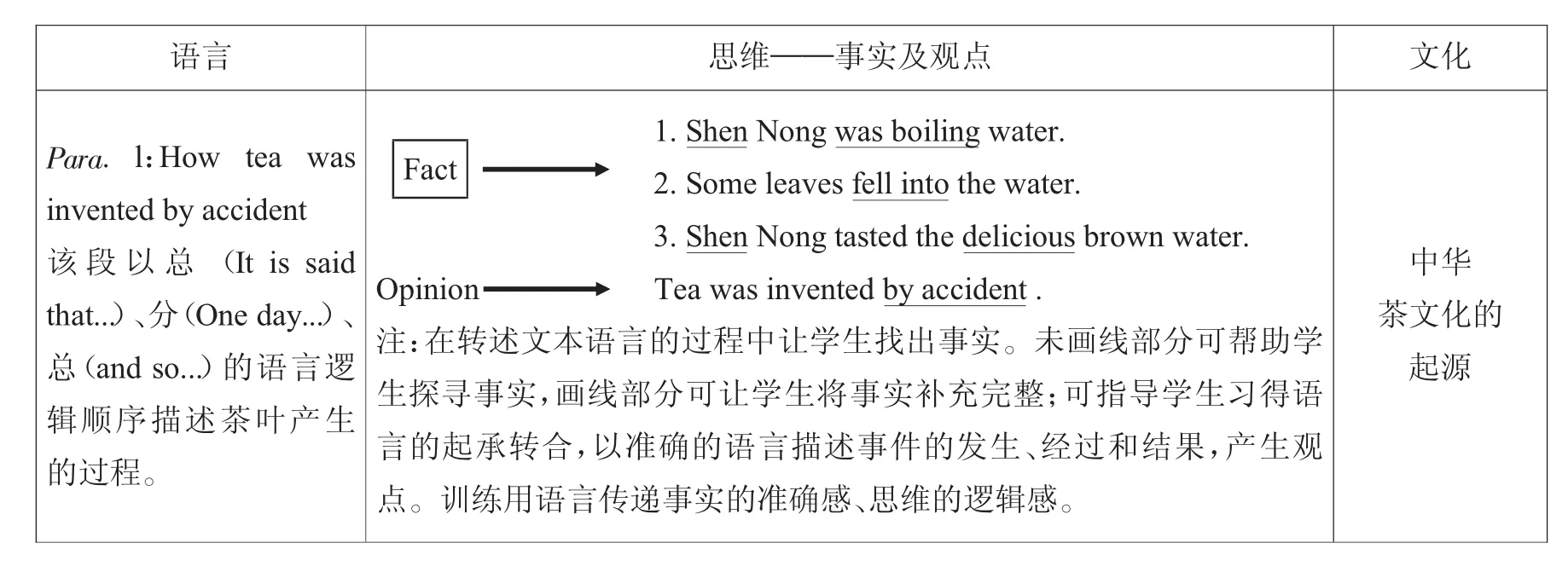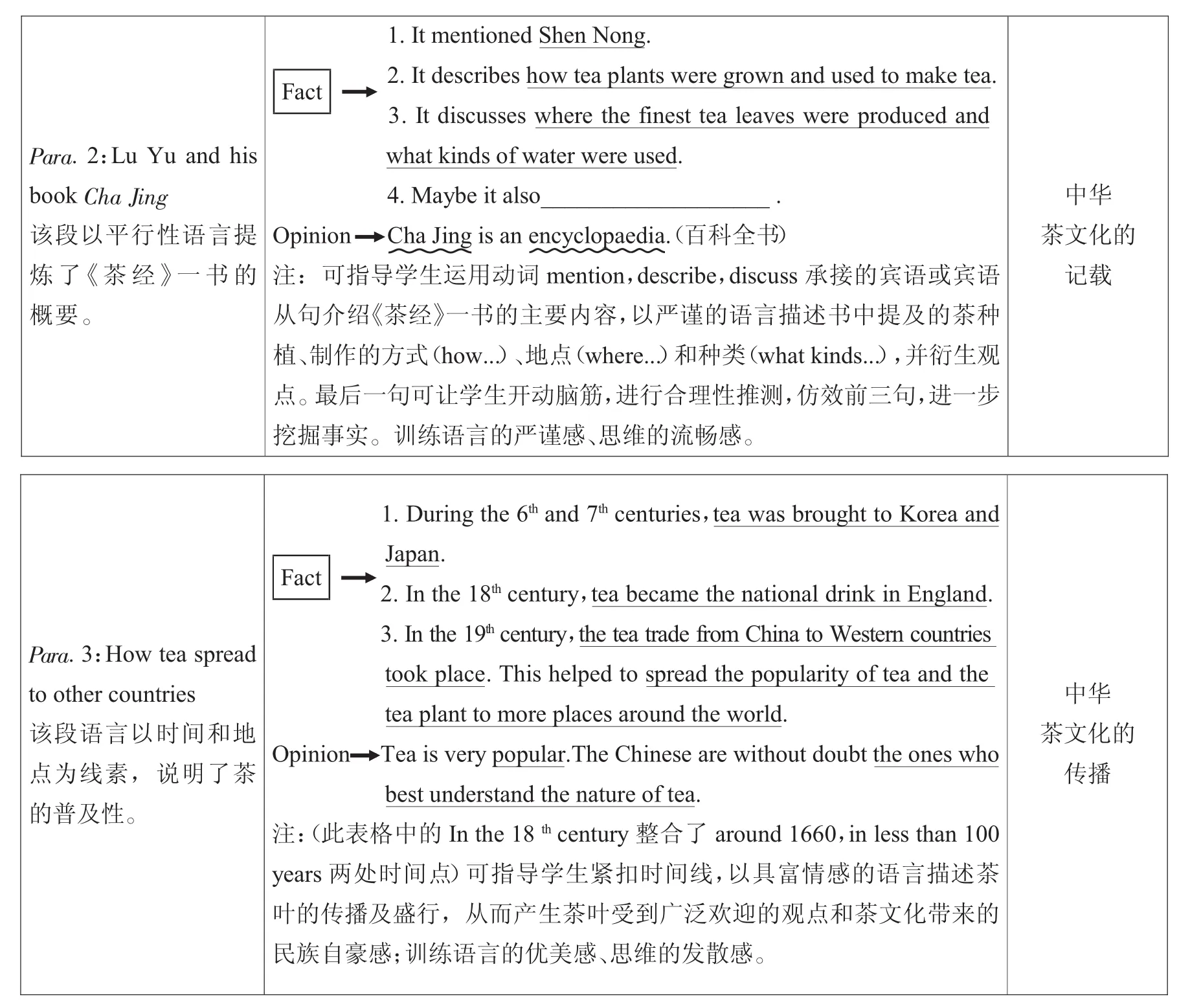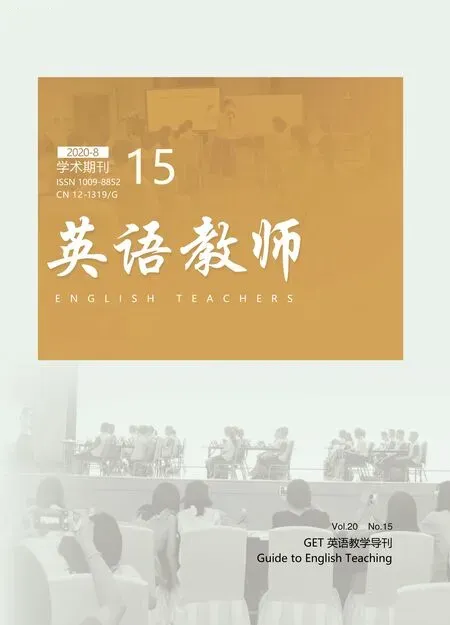AIDA三维模式在初中英语阅读课中的运用
何 娟
引言
阅读的本质即理解文本、学习文本,然后构建新文本(史蒂文·罗杰·费希尔 2009),而理解文本、学习文本、构建新文本均离不开对情境活动的理解和创设。建构主义认为教学应创设一种与现实情境相类似的真实情境,以解决学生在现实生活中遇到的问题为目标,让他们在解决具体问题的过程中实现对知识的主动探索、主动发现和对所学知识意义的主动建构。在初中英语阅读教学中,创设情境活动赋予阅读过程以生命力。
阅读行为是解码过程,是读者理解并阐释文本的事、意、情、景的过程,也是读者将意义赋予所看到文字的过程(史蒂文·罗杰·费希尔 2009)。情境活动则引导学生激活信息,构建对作者所传达信息的合理解释。可以这样认为,合适的情境活动促进有效阅读行为的发生。
世界著名推销专家海因兹·姆·戈德曼(Heinz M Goldmann)曾提出爱达公式(AIDA),即通过对话、示范、帮助确认等吸引注意、兴趣,促成欲望、情感达成。教师可以尝试以其为向导,将其转化为AIDA阅读行为,运用于九年级英语阅读教学。
AIDA阅读行为三维模式:
首先,注意与兴趣。引起学生注意(Attention),即在创设的情境活动中促使他们集中注意力,唤起其兴趣(Interest),促使他们对文本探究抱有期待和积极肯定的态度。
其次,激起学生的交流欲望(Desire)。即促使学生理解文本情境,运用一定的阅读策略,活化其思维。
最后,升华积极情义体验(Affection)。即教师创设情境,迁移至学生生活,调动情感因素,促使他们主动分享新观点、产生新期待。
以下从三个维度加以阐释。
一、造境维度:牵引思维路径,唤起注意与兴趣
引用艺术领域的“造境”之说,即在具象的基础上形成一种场、一种氛围、一种透明的空间。营造可唤起注意力与兴趣点的情境,并指向文本图片。经典语句、学生先前经验、师生信息差等均可造境。
【案例1】人教版新目标《英语》九年级Unit 2 Full Moon,Full Feelings
该阅读文本的主题为“中华传统节日——中秋节”。教师可以运用中国古诗词造境,师生共同赏析,以吸引学生的注意力,激发其兴趣。
T:Shall we enjoy some sentences from Sushi’s poems?Who wants to read them?
S1:Let me try.“但愿人长久,千里共婵娟。”
S2:“中秋谁与共孤光。把盏凄然北望。”
T:What do you think“婵娟”mean?
S3:I think it means the moon.
T:What may it like?
S4:It may like a round plate.
T:I think so.It’s a full moon.The full moon can especially express full feelings.
T:What do you think“孤光”mean?
S5:It means the moonlight.
S6:It means the moonlight on the Mid-Autumn Festival.
T:Well,today’stopicis—Fullmoon, Full feelings.
打通学科界限,将中华古诗词适时运用于文本分析之前,营造意境,不仅能使学生兴致盎然,还能聚焦文本主题。
【案例2】人教版新目标《英语》九年级Unit 5 Beauty in Common Things
教师可以从标题中的common一词入手,引导学生通过对八年级(上)Unit 5阅读文本中Mickey Mouse形象的回顾,从已有经验入课,打开文本视野。
T:Let me test your memory.What does Mickey Mouse look like?
S1:Mickey Mouse is like a common man.
T:But what did he always try to do?
S2:He always tried to face any danger.
T:So Mickey Mouse is also special.Who turned a common mouse into special Mickey Mouse?
S3:Walt Disney.
T:A common mouse was turned into special Mickey Mouse by Walt Disney.These are common things.(展示纸张、竹子、泥土等原材料)What are they turned into?(展示孔明灯、窗花、陶泥等工艺品)
S4:They are turned into sky lanterns,paper cutting and clay art.
T:Wow,they are common but...(在入课交流中聚焦common一词,是因为在后续的文本探究中还需回视common,beauty,体味前后的分析梯度。)
S5:They are common but beautiful.
T:OK.Let’s read the text Beauty In Common Things together.
在师生对话中,从能引发学生后续探究的词汇入手,结合其已有的文本经验,激活“原有发展区”,指向“最近发展区”;营造探究新文本的情境,进入新的主题语境。
【案例3】人教版新目标《英语》九年级Unit 6 An Accidental Invention
该文本的主题为“茶”。
T:Today we’ll talk about tea.In this title An AccidentalInvention,which word are you more interested in,“accidental”or“invention”?
S1:I’m more interested in“accidental”because there must be an interesting story.
S2:I’m more interested in“invention”because I want to know why tea is an invention.
T:The title also catches my eyes.Let’s read the text together.
简洁的文题造境既能聚集学生的注意力,又能激发他们阅读探究的兴趣。
在“造境”维度中,教师可通过古诗句、先前文本经验、标题等引起学生的注意(Attention)。语言能力是在社会情境中借助语言,以听、说、读、看、写等方式理解和表达意义的能力。在“造境”时,教师应注重开展前后关照的课堂对话,唤起学生阅读文本的兴趣(Interest),从而训练其逻辑思维能力,使其主动、进一步探究文本。
二、入境维度:训练高阶思维,内聚阅读热望
当前,批判性思维、创造性思维等高阶思维正日益得到凸显。真正有价值的课堂不是呈现教师预设好的材料和答案,而是作用于学生、生成于课堂中的思维品质的呈现。所以,批判性思维等高阶思维是品质课堂的内涵走向。在阅读中培养高阶思维,就要求读者在阅读过程中利用分析、质疑、推理、评价等思维方法,达到对阅读文本的深刻理解(李善良 2012)。
【案例1】人教版新目标《英语》九年级Unit 2 Full Moon,Full Feelings
依据英语学科能力要素及表现指标框架,教师应引导学生通过比较、分析、评价等方式,将语言、文化、思维三者融为一体,建构新知,在解决问题的过程中发展语言能力(徐静芳、高姿 2019)。
根据该文本中语句之间的逻辑关系,教师可运用相关阅读策略,引导学生更新思维。
T:However,a bad man,Pang Meng tried to steal the medicine.What does “steal”here mean?“偷”or“不正当地获得”?(指导学生关注词汇的准确含义。)
S1:不正当地获得。
T:Which sentence can help you infer this meaning?(引导学生联系上下文进行推断。)
S1:The next sentence is “Chang’e refused to give it to him and took it all”.It means she saw Pang Meng do it.
T:Well,you are good at thinking.Do you think thereis something missing between thesetwo sentences?(进一步引导学生关注语言背后的思维,鼓励他们补白文本。)
S2:Pang Meng forced Chang’e to give the medicine to him.
T:What can you read from these two sentences?—“Hou Yi was so sad that he called out her name to the moon every night.”“How he wished that Chang’e could come back!”(在语言、思维意识的递进中,引领学生树立传统文化意识。)
S3:The full moon expresses Hou Yi’s strong feelings.
S4:When Hou Yi enjoyed the full moon on Mid-autumn Festival,he missed Chang’e very much.
T:How might Chang’e feel?
S5:She might feel lonely.
T:Chang’e missed Hou Yi,too.I’m sure.
在入境阅读中,教师应引导学生更多地关注文本,细细探究篇章。入境,即通过提取、转述、补白,赏析文本语言,达成思维的递进。
【案例2】人教版新目标《英语》九年级Unit 5 Beauty in Common Things
该文本结构鲜明,教师可抓住结构、内容及作者如何建立起结构和内容之间的联系,分析具体信息,并基于语言、思维、文化整体理解、强化语用、合理表意。教师还可以以直观的思维导图让抽象思维具体化、可视化。在整体阅读并判断文本结构(第1段总,第2、3、4段分)之后,教师可以以第2、3段的语言特征和结构为切入口,示范并与学生合作完成思维导图。第4段则让学生小组讨论完成思维导图(见下图)。
S1:As for the feature,the clay pieces are small and they look real.
S2:They are also cute and lovely.
S3:They are the symbols for love.
S4:Clay art is also the symbol of Chinese culture.
S5:Clay art shows the love all Chinese people have for life and beauty.
在运用思维导图的过程中,教师充当语言运用协助者、思维活动组织者和情感文化指引者的角色,启发学生进行语言、思维、文化三个层面的思考和讨论,并借助对文本语言深层含义的分析,聚焦作者的情感、态度、价值观。教师在阅读中激发学生思考的热情,拓宽其思维,引导他们积极地解析、应用、评估语言。
【案例3】人教版新目标《英语》九年级Unit 6 An Accidental Invention
综观新目标九年级的叙事文本,有事件的起承转合、有语言的峰回路转。总体看来,事实居多、观点偏少,需要进一步挖掘文本,开展情境活动,激发学生交流的欲望;需要优化阅读策略,从信息整合到发现观点、从语言结构到语言运用,活化学生的思维活动,让其思维的逻辑性、批判性得以渐次挖掘,让语言、思维、文化达成和谐统一。
教师对该文本语言、思维、文化的三维统整列表分析如下:

语言思维——事实及观点文化P a r a.l:H o w t e a w a s i n v e n t e d b y a c c i d e n t该段以总(I t i s s a i d t h a t...)、分(O n e d a y...)、总(a n d s o...)的语言逻辑顺序描述茶叶产生的过程。1.S h e n N o n g w a s b o i l i n g w a t e r.2.S o m e l e a v e s f e l l i n t o t h e w a t e r.3.S h e n N o n g t a s t e d t h e d e l i c i o u s b r o w n w a t e r.O p i n i o n T e a w a s i n v e n t e d b y a c c i d e n t.注:在转述文本语言的过程中让学生找出事实。未画线部分可帮助学生探寻事实,画线部分可让学生将事实补充完整;可指导学生习得语言的起承转合,以准确的语言描述事件的发生、经过和结果,产生观点。训练用语言传递事实的准确感、思维的逻辑感。F a c t中华茶文化的起源

P a r a.2:L u Y u a n d h i s b o o k C h a J i n g该段以平行性语言提炼了《茶经》一书的概要。1.I t m e n t i o n e d S h e n N o n g.2.I t d e s c r i b e s h o w t e a p l a n t s w e r e g r o w n a n d u s e d t o m a k e t e a.3.I t d i s c u s s e s w h e r e t h e f i n e s t t e a l e a v e s w e r e p r o d u c e d a n d w h a t k i n d s o f w a t e r w e r e u s e d.4.M a y b e i t a l s o___________________.O p i n i o n C h a J i n g i s a n e n c y c l o p a e d i a.(百科全书)注:可指导学生运用动词m e n t i o n,d e s c r i b e,d i s c u s s承接的宾语或宾语从句介绍《茶经》一书的主要内容,以严谨的语言描述书中提及的茶种植、制作的方式(h o w...)、地点(w h e r e...)和种类(w h a t k i n d s...),并衍生观点。最后一句可让学生开动脑筋,进行合理性推测,仿效前三句,进一步挖掘事实。训练语言的严谨感、思维的流畅感。F a c t中华茶文化的记载F a c t P a r a.3:H o w t e a s p r e a d t o o t h e r c o u n t r i e s该段语言以时间和地点为线素,说明了茶的普及性。1.D u r i n g t h e 6 th a n d 7 th c e n t u r i e s,t e a w a s b r o u g h t t o K o r e a a n d J a p a n.2.I n t h e 1 8 th c e n t u r y,t e a b e c a m e t h e n a t i o n a l d r i n k i n E n g l a n d.3.I n t h e 1 9 th c e n t u r y,t h e t e a t r a d e f r o m C h i n a t o W e s t e r n c o u n t r i e s t o o k p l a c e.T h i s h e l p e d t o s p r e a d t h e p o p u l a r i t y o f t e a a n d t h e t e a p l a n t t o m o r e p l a c e s a r o u n d t h e w o r l d.O p i n i o n T e a i s v e r y p o p u l a r.T h e C h i n e s e a r e w i t h o u t d o u b t t h e o n e s w h o b e s t u n d e r s t a n d t h e n a t u r e o f t e a.注:(此表格中的I n t h e 1 8 th c e n t u r y整合了a r o u n d 1 6 6 0,i n l e s s t h a n 1 0 0 y e a r s两处时间点)可指导学生紧扣时间线,以具富情感的语言描述茶叶的传播及盛行,从而产生茶叶受到广泛欢迎的观点和茶文化带来的民族自豪感;训练语言的优美感、思维的发散感。中华茶文化的传播
综上,在“入境”维度中,通过推测补白、思维导图、归纳列表等策略促使学生挖掘深层信息,并在此过程中训练其思维,内聚其热望(Desire),使其渐入文本佳境。另外,在引导学生分析事实、传递观点的同时,让其感知文本语言的准确度、流畅性,体味语言的优美感。
三、化境维度:指向语言赏析,升华正向情感
英语学科核心素养中对文化意识这样解读:学生能形成正确的价值观念和道德情感,具备一定的跨文化沟通和传播优秀文化的能力。了解是欣赏的预备,欣赏是了解的成熟,了解和欣赏是互相补充的(朱光潜 2016)。只有回视文本并关联文本及学生的生活世界,才可自然生成情义体验。
【案例1】人教版新目标《英语》九年级Unit 2 Full Moon,Full Feelings
情感体验的本源是积极的阅读体验,强调读者能够从阅读中获得情感成就,包括态度、兴趣和自我评估。学生资源蕴藏在每个学生的生活经历和学习体验之中,也蕴藏在他们丰富的情感和活跃的思维之中(教育部 2012)。在分析完该文本后,教师可以引导学生移步换景,将情感融化于生活情境中。
T:Can you describe the story?
S1:It’s a sad story.
S2:It’s a moving story.
S3:It’s a beautiful story.
T:This story has colorful feelings,the moon carries people’s wishes.What do you want to say to your parents if you can’t enjoy the Mid-Autumn Festival together with them one day?(假设潜在的生活场景。学生易产生代入感,有话可说。)
S4:I miss you very much,Mum.Keep healthy!
S5:Don’t smoke too often.Eat more fruits.
S6:I hope you can come to my city and we can enjoy ourselves every day!
在代入感较强的情境中,学生结合体验过的文本,又跳出文本,联系自己的未来生活,流露出真实的情感。
【案例2】人教版新目标《英语》九年级Unit 5 Beauty in Common Things
通过深层信息的整合、标题的再勘探,牵引语言赏析感,挖掘文本价值观。
T:How can the common things be turned into beauty?(信息整合、加工能力的激发。)
S1:Through hard work,creative mind,wisdom and so on.
T:Let’s come back to the title —“Beauty in Common things”.What do you think“beauty”means now?(语言赏析、情感体验的激发。)
S2:Beauty of traditional Chinese art forms.
S3:Beauty of hard work.
S4:Beauty of creative mind.
S5:Beauty of wisdom.
T:So we should see the beauty behind the effort of common people.
T:If you were the writer,what title will you give?(创造性思维的激发。)
S6:Beauty in Common Life.
S7:Common but Beautiful.
S8:Common People creates Beauty.
通过回视标题,在深阅读后捕捉标题的内涵、赏析语言魅力、探究作者意图,甚至通过标题再创作,融入学生的语言创造和情感意识。
【案例3】人教版新目标《英语》九年级Unit 6 An Accidental Invention
茶文化中有历史、文学、艺术,也有人际沟通。这种人际沟通可以通过操作性实践搭建。
T:This text tells us that the Chinese are without doubt the ones who best understand the nature of tea.What do you think“the nature of tea”mean?
S1:I can’t express it in English clearly.
T:Well,I’d like to give you some words to choose.(教师提供参考性词汇。)
S2:It means grace.
S3:It means respect and calmness.
T:Would you like to drink tea quickly or taste tea gently with others?Why?
S4:I’d like to taste tea.Because tasting tea gently shows grace,respect and calmness.
T:Tasting tea is like communicating with a good friend.So I’d like to have friends like tea and have tea like friends.
课堂话语是既充满矛盾又不断得到调整并得以多元并存的。倾听每一个学生的困惑与沉默,正是课堂教学的出发点(钟启泉 2017)。在进一步的课堂沟通中,教师可以通过追问及自己追加观点的方式进一步构建课堂话语、交流思想、升华情感体验。
T:Since you would like to taste tea,do you want to have a try now?
S5&S6:Let me try.(水温雅,茶温雅,古今幽情一杯茶。教师辅助学生亲历实践,泡上一杯茶。在一起一落一拱手的过程中感悟中华茶道的魅力。)
语言与文化的关系密不可分,语言是文化的载体,是通向民族文化核心的一把钥匙。用英语讲述中华茶文化的同时,辅之以实践性操作,有助于将行为文化沉浸、融化于真实情境中。
在“化境”维度中,代入生活、回视标题、操作实践等情境活动能促使学生产生语用意识,开启创造性,升华情感和价值观。这样,学生愿意用语言做事,化入生活情境,回归生活世界。
结语
综上所述,在初中英语阅读课中运用AIDA三维模式有助于优化学生的阅读行为。通过经典语句、先前文本经验、标题等“造境”,唤起学生注意及兴致,开启思维训练;通过推测补白、思维导图、归纳列表等“入境”,引导学生发现事实、阐释观点,指向高阶思维,强化其表述的热望;通过代入生活情境、回视标题并研讨、亲历实践的操作等“化境”,让学生在运用语言的过程中发现美、感受美,形成价值共鸣,并产生传播中华优秀文化的美好情怀。

